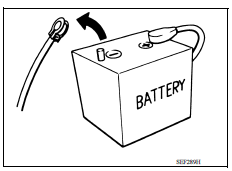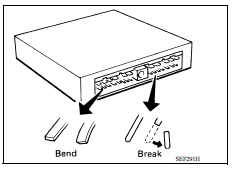Nissan Versa (N17): Precautions
Precaution for Supplemental Restraint System (SRS) "AIR BAG" and "SEAT BELT PRE-TENSIONER"
The Supplemental Restraint System such as "AIR BAG" and "SEAT BELT PRE-TENSIONER", used along with a front seat belt, helps to reduce the risk or severity of injury to the driver and front passenger for certain types of collision. This system includes seat belt switch inputs and dual stage front air bag modules. The SRS system uses the seat belt switches to determine the front air bag deployment, and may only deploy one front air bag, depending on the severity of a collision and whether the front occupants are belted or unbelted.
Information necessary to service the system safely is included in the SR and SB section of this Service Manual.
WARNING:
- To avoid rendering the SRS inoperative, which could increase the risk of personal injury or death in the event of a collision which would result in air bag inflation, all maintenance must be performed by an authorized NISSAN/INFINITI dealer.
- Improper maintenance, including incorrect removal and installation of the SRS, can lead to personal injury caused by unintentional activation of the system. For removal of Spiral Cable and Air Bag Module, see the SR section.
- Do not use electrical test equipment on any circuit related to the SRS unless instructed to in this Service Manual. SRS wiring harnesses can be identified by yellow and/or orange harnesses or harness connectors.
PRECAUTIONS WHEN USING POWER TOOLS (AIR OR ELECTRIC) AND HAMMERS
WARNING:
- When working near the Airbag Diagnosis Sensor Unit or other Airbag System sensors with the Ignition ON or engine running, DO NOT use air or electric power tools or strike near the sensor(s) with a hammer. Heavy vibration could activate the sensor(s) and deploy the air bag(s), possibly causing serious injury.
- When using air or electric power tools or hammers, always switch the Ignition OFF, disconnect the battery, and wait at least 3 minutes before performing any service.
Service Notice and Precautions for EPS System
- Check the following item when performing the trouble diagnosis.
- Check any possible causes by interviewing the symptom and it′s condition from the customer if any malfunction, such as EPS warning lamp is turned ON, occurs.
- Check if air pressure and size of tires are proper, the specified part is used for the steering wheel, and control unit is genuine part.
- Check if the connection of steering column assembly and steering gear assembly is proper (there is not looseness of bolts, damage of rods, boots or sealants, and leakage of grease, etc.).
- Check if the wheel alignment is adjusted properly.
- Check if there is any damage or modification to suspension or body resulting in increased weight or altered ground clearance.
- Check if installation conditions of each link and suspension are proper.
- Check if the battery voltage is proper.
- Check connection conditions of each connector are proper.
- Before connecting or disconnecting the EPS control unit harness connector, turn ignition switch "OFF" and disconnect battery ground cable. Because battery voltage is applied to EPS control unit even if ignition switch is turned "OFF".

- When connecting or disconnecting pin connectors into or from EPS control unit, take care not to damage pin terminals (bend or break).
- When connecting pin connectors, make sure that there are no bends or breaks on EPS control unit pin terminal.
- During quick steering, rasping noise may be heard from around the steering wheel. This is not a malfunction. The noise is an operating noise of the EPS system under normal conditions. If the rasping noise occurs during slow steering, this may not be an operating noise of the system. In this case, it is necessary to find out the location of the noise and repair, if necessary.

SYSTEM DESCRIPTION
COMPONENT PARTS
Component Parts Location

1. ABS actuator and electric unit (control unit) 2. ECM 3. Combination meter 4. EPS motor 5. Reduction gear 6. EPS control unit 7. Torque sensor A. Steering column assembly (view with removed from vehicle) B. EPS warning lamp (In combination meter)
Component Description
| Components parts | Reference |
| EPS control unit | STC "EPS Control Unit" |
| EPS motor | STC "EPS Motor" |
| Torque sensor | STC "Torque Sensor" |
| Reduction gear | STC "Reduction Gear" |
| EPS warning lamp | STC "EPS SYSTEM : System Description" |
| ECM | - Transmits mainly the following signals to EPS control unit via
CAN communication. - Engine status signal |
| ABS actuator and electric unit (control unit) | - Transmits mainly the following signal to EPS control unit via
CAN communication. - Vehicle speed signal (ABS) |
| Combination meter | - Transmits mainly the following signal to EPS control unit via
CAN communication. - Vehicle speed signal (METER) - Turns ON the EPS warning lamp according to the signal from EPS control unit via CAN communication. |
EPS Control Unit
- EPS control unit performs an arithmetical operation on data, such as steering wheel turning force (sensor signal) from the torque sensor, vehicle speed signal, etc. Then it generates an optimum assist torque signal to the EPS motor according to the driving condition.
- EPS control unit decreases the output signal to EPS motor while extremely using the power steering function (e.g., full steering) consecutively for protecting EPS motor and EPS control unit (Overload protection control).
EPS Motor
EPS motor provides the assist torque by the control signal from EPS control unit.
Torque Sensor
Torque sensor detects the steering torque, and transmit the signal to EPS control unit.
Reduction Gear
Reduction gear increases the assist torque provided from EPS motor with worm gears, and outputs to the column shaft.
SYSTEM
 Steering gear and linkage
Steering gear and linkage
Exploded View 1. Joint cover 2. Steering gear assembly 3. Inner socket 4. Large clamp 5. Boot 6. Small boot clamp 7. Outer socket ...
EPS System
EPS SYSTEM : System Description EPS control unit performs an arithmetical operation on data, such as steering wheel turning force (sensor signal) from the torque sensor, vehicle speed signal, ...
Other materials:
Instrument panel
1. Headlight/turn signal switch/fog light
switch (if so equipped)
2. Driver's supplemental air bag (P. 1-39)
Horn
3. Meters and gauges. Warning and indicator lights
4. Wiper and washer switch
5. Vents
6. Rear window defroster switch
7. Front passenger air bag status light
8. Hazard warn ...
Instrument panel
1. Headlight/turn signal switch/fog light
switch (if so equipped)
2. Driver's supplemental air bag (P. 1-39)
Horn
3. Meters and gauges. Warning and indicator lights
4. Wiper and washer switch
5. Vents
6. Rear window defroster switch
7. Front passenger air bag status light
8. Hazard warn ...
Categories
- Manuals Home
- Nissan Versa Owners Manual
- Nissan Versa Service Manual
- Video Guides
- Questions & Answers
- External Resources
- Latest Updates
- Most Popular
- Sitemap
- Search the site
- Privacy Policy
- Contact Us
0.0076
